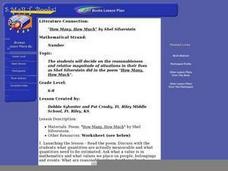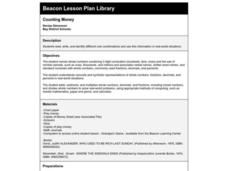Busy Teacher’s Café
"Smart" by Shel Silverstein
Find out just how smart your young mathematicians are with this cross-curricular math and language arts lesson. After first reading Shel Silverstein's poem "Smart", learners draw pictures of coins to model the different exchanges...
Curated OER
Recycling/Solid Waste Education with Shel Silverstein: "Sarah Cynthia Sylvia Stout"
Both poetry analysis and waste disposal are more engaging topics for young readers with a instructional activity to accompany the Shel Silverstein poem 'Sarah Cynthia Sylvia Stout Would Not Take the Garbage Out" from Where the Sidewalk...
Curated OER
Smart- Counting Coins
Students discover the name and value of coins. In this counting money instructional activity, students identify heads and tails of coins and the value of each coin. Students visit websites and play games. Students then write a poem...
Curated OER
poem "Smart" by Shel Silverstein from "Where the Sidewalk Ends"
Students explore unit rate and ratio and discuss the relationship.
Curated OER
poem "Smart" by Shel Silverstein from "Where the Sidewalk Ends"
Students incorporate their conceptual understanding of proportions to write a creative piece similar to the example poem.
Curated OER
"How Many, How Much" by Shel Silverstein
Students decide on the reasonableness and relative magnitude of situations in their lives as Shel Silverstein did in the poem "How Many, How Much."
Curated OER
Literature Based Money Countdown Challenge
In this money worksheet, students complete two tables using the references to money in two pieces of children's literature. They work with Judith Viorst's, Alexander, Who Used to Be Rich Last Sunday and Shel Silverstein's poem, "Smart."
Curated OER
Six Trait Writing with Charles Dickens and Shel Silverstein
Second graders identify the traits of good writing in poems and stories in the six lessons of this unit. The traits analyzed are used to improve the student's own writing skills.
Curated OER
poem "One Inch Tall" from the book "Where the Sidewalk Ends" by Shel Silverstein
Learners use the terms: ratio, proportion, and measurement in their description of the life of a person one inch tall.
Curated OER
"Colors" a poem by Shel Silverstein
Students collect data, graph it, and use the data to find measures of central tendencies, and find probabilities.
Curated OER
Deena's Lucky Penny
Students discover the coin denominations of U.S. Currency. In this money lesson, students read the book Deena's Lucky Penny, then complete a coin matching activity using the Internet. Students also read Shel Silverstein's...
Curated OER
Elementary Economics:Making Smart Choices
Students understand what good and bad choices are in regards to money and review and reinforce the value of each coin. They identify parts of a story as well as the sequencing. They then create their own sequence of events in words...
Curated OER
Money Madness
Second graders review coins and their values. In this coin recognition lesson, 2nd graders review the coin values as they read 'Smart' by Shel Silverstein. Students use class computer demonstrations to identify the coin's names, worth,...
Curated OER
Teaching Money
Learners identify coin/money values, write amounts of money and calculate change. The poem, "Smart" by Shel Silverstein is used in this lesson.
Curated OER
"A Closet Full of Shoes" and Picture Puzzle Piece" by Shel Silverstein
Students explain the concept of simple probability.
Curated OER
Counting Money
Students discover the importance of economics through Shel Silverstein's poem Smart. Students are introduced to the concept of earning money and using money to purchase necessary items, after becoming familiar with U.S. money.
Curated OER
Are You Money Smart?
Learners figure out and discuss the irony of this coin-centric poem. They also practice persuasive letter writing, and identify and count coin/money values.
Curated OER
Money Counts
Fourth graders identify bills and coins to $20 bills and make equivalencies. They organize bills and coins in groups from greatest to least and least to greatest. Students count out change.
Curated OER
Counting Money
Students read, write, and identify different coin combinations and use this information in real-world situations.
Curated OER
What Do You See?
Young scholars practice visualizing elements from a poem or story. While reading a poem aloud, the instructor models what they see as they read the passage. Students draw a picture of the main character of the story "Because of...
Curated OER
Teaching Money
Students identify the coins and bills used in the United States. They write the amounts of each bill and coin and practicing counting different amounts. They follow a demonstration about how to count money as well.
Curated OER
Where'd You Get That Paper and Pencil?
Third graders make a poster display of objects made from trees. In this wood products lesson, 3rd graders read "The Giving Tree," discuss things that are produced from trees and watch the videos "Let's Make a Pencil," and "How Paper is...
Curated OER
A Hodgepodge of Literature
Students complete multiple lessons to study various literature including poetry, fiction, tall tales, and phrases. In this literature lesson, students complete six lessons about poetry, fiction, and idioms.
Writing Fix
Writing Fix: Smart Math and Writing
In this lesson, the poem "Smart" from Where the Sidewalk Ends, by Shel Silverstein, is used as the mentor text. Students will write a map of the poem and then analyze it to discover what happened when trades with money were made and...

























